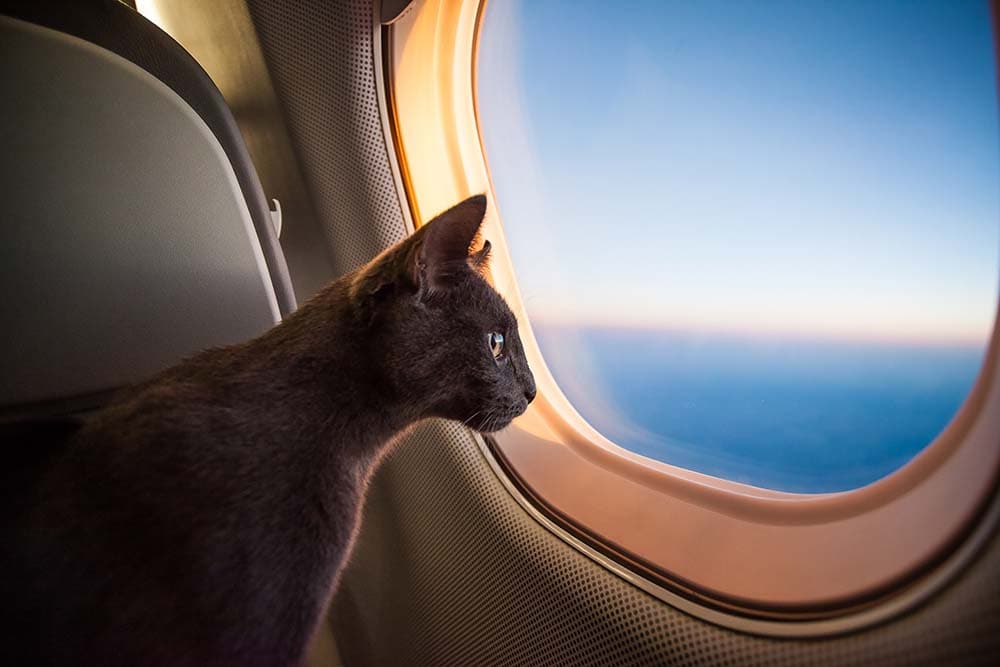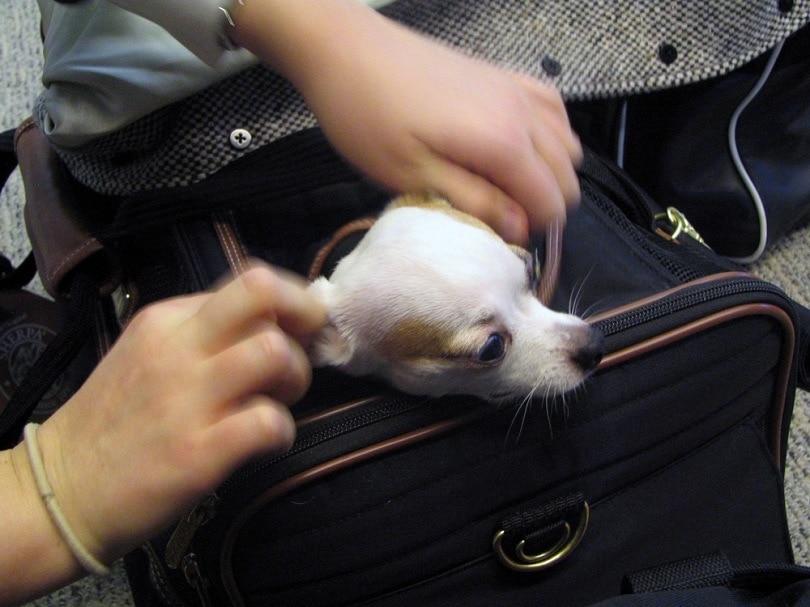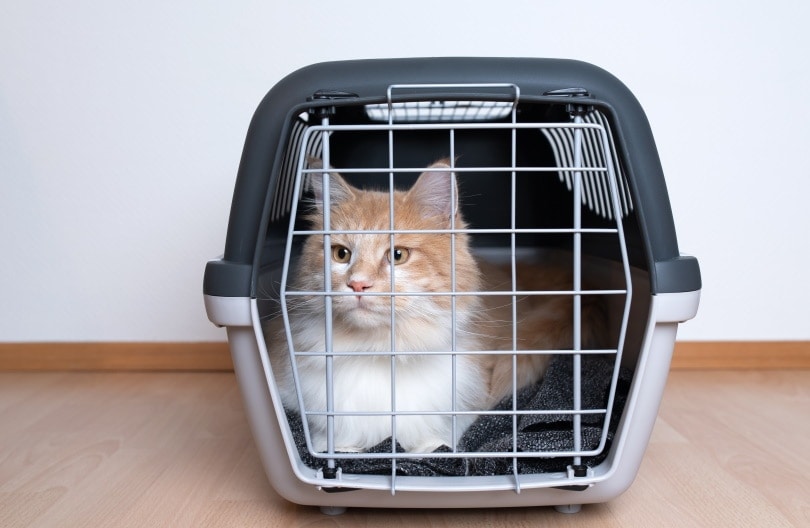Where Do Pets Go On an Airplane? What to Know Before You Go

Updated on

Leaving your dog, cat, or other pet at home on a long trip might seem unthinkable, but flying with a pet isn’t simple either, especially for larger dogs. Flying is generally seen as stressful and frightening for pets, and it can get expensive as well. Every airline has its own rules and safeguards, so it’s important to double-check that your pet meets all the requirements. If you’re just going for a weekend trip, it’s probably not worth it. But if you are moving to a new place or traveling for weeks at a time, flying might be the best option.
Here is some basic info on flying with pets.
Bringing a Carry-On Pet
For cats and small dogs, many airlines allow you to bring a pet into the airline cabin with you. This is generally the cheapest and least stressful option, as you’ll be able to keep your pet near you at all times and monitor its health and safety. Many airports also have pet-friendly zones where you can let your furry friend stretch their legs during the flight.
However, conditions are pretty restrictive—most of the time, you’ll need your pet’s carrier to fit under an airplane seat. You also won’t be able to get your pet out of the crate onboard the plane. Finally, you’ll have to keep your fellow passengers in mind, too—if your pet might howl, meow, or bark when confined for a long flight, carry-on might not be the best choice.
If you do decide to go with a carry-on crate, check your airline’s website for conditions. Most flights require you to pre-register your pet and some might require a certificate of health from your vet or other special paperwork.
Flying With Pets in Cargo
If your pet is too big to fly carry-on, your only alternative is the cargo hold. You’ll have to drop off your crated pet at check-in and pick them up after the plane has landed. Your pet will be transported from the drop-off location to the plane and loaded into the cargo with other pets. Flying in cargo can also add hours of airport time. You may be required to drop your pet off early or at another part of the airport, and it may take up to two hours after disembarking before you can pick your pet up.
Flying with a pet in cargo can be pretty expensive—it often costs hundreds of dollars. It can also be stressful for your pet, who will have to stay in cramped confines and unfamiliar areas for hours on end. But for many pet owners, it’s the only option.
If you want to send your pet via cargo, contact your airline and find out what requirements and restrictions they have for registration.

Is Flying With a Pet Safe?
Flying with a pet might not be pleasant for you or the pet, but it is relatively safe. Hundreds of thousands of pets fly each year, and only a few are lost, injured, or killed each year. For example, in 2019, nearly half a million pets flew, while there were only 11 deaths, 8 injuries, and no lost animals1.
Most of the danger and discomfort to pets comes during the loading and unloading phases. There’s a widespread myth that pets in cargo are kept in a non-climate controlled or even unpressurized cargo hold, but this isn’t true. While on the plane, pets are stored in an area that is similar to the passenger area when it comes to temperature and air quality. But when your pet is being loaded and unloaded, they might be exposed to extreme weather. That’s why many airlines don’t ship pets in the cargo area during bad weather or the summer months.
Experts are divided on whether sedation medications are good for your pets while flying. Some vets will prescribe medication that will calm or sedate your pet to deal with the stress of travel, but this also introduces its own risks of adverse reactions.

Restrictions for Flying With Pets
Every airline has its own restrictions, and it’s hard to make a comprehensive list.
- Weather restrictions: Some airlines ban pets from flying in cargo during certain times of the year or during severe weather. This is because cargo may spend hours in a warehouse or on the pavement getting loaded and unloaded. Other airlines have processes in place for protecting your pet from foul weather.
- Health restrictions: Many airlines require pets to have a vet certificate showing that they are in good health, especially for cargo travel. They may also require proof of certain vaccines.
- Quarantine restrictions: If you’re traveling internationally, your pet might need to be boarded for a quarantine period on arrival. You may also require special paperwork to be allowed to bring a pet into the country, and some countries ban most pet entries.
- Breed and Size Restrictions: Certain breeds of dogs are banned on many airlines because of perceived aggression or health issues. Many breeds prone to respiratory issues, such as Pugs, can’t fly on most airlines.
Preparing Your Pet for Travel
Aside from completing all the necessary paperwork to help your pet travel, it’s also important to prepare your pet and its space. Crate training is a must for traveling pets. Every airline has its own requirements for pet crates and carriers, but in general you’ll want to find a hard-shelled crate that has good ventilation and a leak-proof bottom. You’ll want to give your pet access to water—usually via a bottle strapped to the outside—and possibly food. You’ll also want to label your crate clearly. If your pet is flying via cargo, make sure that “live animal” is visible on your carrier in large letters as well as a “this side up” label or similar marking.
You will also want to tag your carrier with your contact information in case of an emergency. Some owners also attach a meal’s worth of dry food to the outside of their carrier and carry a recent photo of their pet in case the pet gets lost or separated. However, pet loss is quite rare, so these precautions are likely unnecessary.
Final Thoughts
Flying with an animal isn’t for the faint of heart. But if you’re determined to go through with it, it’s vital to stay in contact with your airport and follow all directions to the letter. Proper planning and preparation are key to making the travel experience safe and as comfortable as possible for your pet.
See Also:
- How to Fly With a Cat: 7 Vet-Approved Travel Tips
- How Much Does It Cost to Fly a Dog Internationally
Featured Image Credit: Photo-Spirit, Shutterstock











